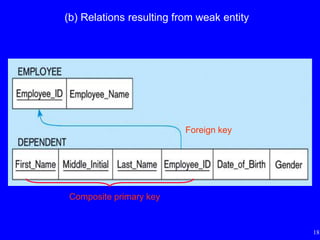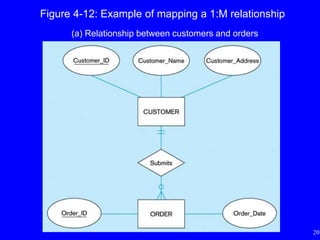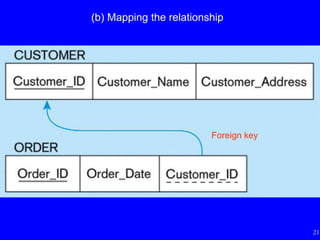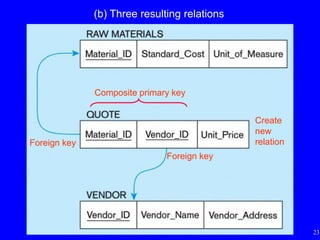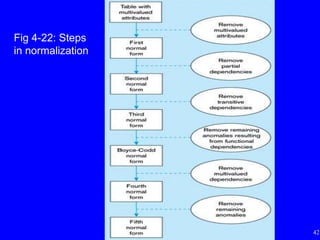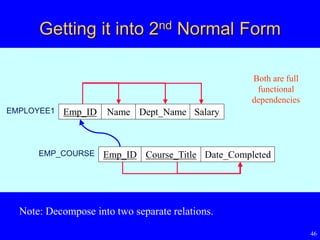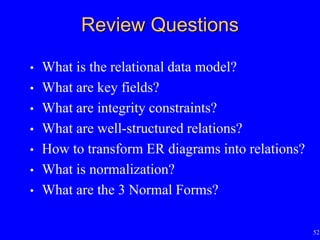Logical database design and the relational model(database)
- 1. Lecture 5: Logical Database Design and the Relational Model ISOM3260, Spring 2014
- 2. 2 Where we are now • Database environment – Introduction to database • Database development process – steps to develop a database • Conceptual data modeling – entity-relationship (ER) diagram; enhanced ER • Logical database design – transforming ER diagram into relations; normalization • Physical database design – technical specifications of the database • Database implementation – Structured Query Language (SQL), Advanced SQL • Advanced topics – data and database administration
- 3. 3 Logical Database Design and the Relational Model • Relational Data Model • Transforming E-R Diagrams into Relations • Normalization
- 4. 4 Relation • A relation is a named, two-dimensional table of data – table is made up of rows (records), and columns (attribute or field) • but not all tables qualify as relations • Requirements: – every relation has a unique name – every attribute value is atomic (not multi-valued, not composite) – every row is unique (can’t have two rows with exactly the same values for all their fields) – attributes (columns) in tables have unique names – the order of the columns is irrelevant – the order of the rows is irrelevant
- 5. 5 Key Fields • Keys are special fields that serve two main purposes: – Primary key is an attribute (or combination of attributes) that uniquely identifies each row in a relation e.g. employee numbers, Hong Kong ID – Foreign key is an attribute (possibly composite) in a relation of a database that serves as the primary key of another relation in the same database represents relationship between two relations • Keys can be simple (a single attribute) or composite (more than one attribute)
- 6. 6 Fig 4-3: Schema for four relations (Pine Valley Furniture) Primary Key Foreign Key Combined, these are a composite primary key … individually they are foreign keys
- 7. 7 Integrity Constraints • Included in relational data model to facilitate maintaining the accuracy and integrity of data • Domain Constraints – allowable values for an attribute – e.g. data type and size • Entity Integrity – no primary key attribute may be null – all primary key fields must have data • Referential Integrity – rule that states that either each foreign key value must match a primary key value in another relation or the foreign key value must be null
- 8. 8 Fig 4-5: Referential integrity constraints (Pine Valley Furniture) Referential integrity constraints are drawn via arrows from dependent to parent table Foreign key
- 9. 9 Well-Structured Relations • Well-structured relations – a relation that contains minimal data redundancy and allows users to insert, delete, and modify rows without causing data inconsistencies (or anomalies) • Types of anomalies – Insertion anomaly adding new rows forces user to create duplicate data – Deletion anomaly deleting rows may cause a loss of data that would be needed for other future rows – Modification anomaly changing data in a row forces changes to other rows because of duplication
- 10. 10 Example – Figure 4-2b • Insertion – can’t enter a new employee without having the employee take a class. • Deletion – if we delete employee 140, we lose information about the existence of a Tax Acc class. • Modification – giving a salary increase to employee 100 forces us to update multiple records.
- 11. 11 Example – Well-Structured Relations EMPLOYEE1 EMP_COURSE
- 12. 12 Transforming E-R Diagrams into Relations 1. Mapping Regular Entities to Relations – Simple attributes E-R attributes map directly onto the relation – Composite attributes use only their simple, component attributes – Multi-valued attribute becomes a separate relation with a foreign key taken from the original entity
- 13. 13 (a) CUSTOMER entity type with simple attributes Figure 4-8: Mapping a regular entity (b) CUSTOMER relation
- 14. 14 (a) CUSTOMER entity type with composite attribute Figure 4-9: Mapping a composite attribute (b) CUSTOMER relation with address detail
- 15. 15 Figure 4-10: Mapping an entity with multi-valued attribute Multi-valued attribute becomes a separate relation with foreign key
- 16. 16 Transforming E-R Diagrams Into Relations 2. Mapping Weak Entities – becomes a separate relation with a foreign key taken from the identifying entity – primary key composed of partial identifier of weak entity primary key of identifying relation (strong entity)
- 17. 17 Figure 4-11: Example of mapping a weak entity (a) Weak entity DEPENDENT
- 18. 18 (b) Relations resulting from weak entity Foreign key Composite primary key
- 19. 19 Transforming E-R Diagrams Into Relations 3. Mapping Binary Relationships – One-to-Many primary key on the one side becomes a foreign key on the many side – Many-to-Many create a new relation with the primary keys of the two entities as its primary key – One-to-One primary key on the mandatory side becomes a foreign key on the optional side avoids the need to store null values in the foreign key any attributes associated with the relationship are also included in the same relation as the foreign key
- 20. 20 Figure 4-12: Example of mapping a 1:M relationship (a) Relationship between customers and orders
- 21. 21 (b) Mapping the relationship Foreign key
- 22. 22 Figure 4-13: Example of mapping an M:N relationship (a) Supplies relationship (M:N) Note: The Supplies relationship will become a separate relation
- 23. 23 (b) Three resulting relations Create new relationForeign key Foreign key Composite primary key
- 24. 24 Figure 4-14a: Mapping a binary 1:1 relationship (a) Binary 1:1 relationship
- 25. 25 (b) Resulting relations Note: Nurse_in_Charge is another name for Nurse_ID. Attribute attached to relationship is stored with foreign key.
- 26. 26 Transforming E-R Diagrams Into Relations 4. Mapping Associative Entities – Identifier not assigned default primary key for the associative relation is the primary keys of the two entities – Identifier assigned when it is natural and familiar to end-users default identifier may not uniquely identify instances of the associative entity
- 27. 27 Figure 4-15a: Mapping an associative entity with no assigned identifier
- 28. 28 (b) Three resulting relations Note: Default primary key for the associative relation is the primary keys of the two entities.
- 29. 29 Figure 4-16: Mapping an associative entity with an identifier (a) Associative entity (SHIPMENT)
- 30. 30 (b) Three relations Note: Customer_ID and Vendor_ID together do not uniquely identify the SHIPMENT relation.
- 31. 31 Transforming E-R Diagrams Into Relations 5. Mapping Unary Relationships – One-to-Many recursive foreign key in the same relation a foreign key in a relation that references the primary key values of that same relation – Many-to-Many create two relations – one for the entity type – one for an associative relation in which the primary key has two attributes, both taken from the primary key of the entity
- 32. 32 Figure 4-17: Mapping a unary 1:N relationship Note: Manager_ID and Employee_ID refer to the same primary key of the relation. Manager_ID is a foreign key that references itself.
- 33. 33 Figure 4-18: Mapping a unary M:N relationship Note: Item_No and Component_No refer to the same primary key.
- 34. 34 Transforming E-R Diagrams Into Relations 6. Mapping Ternary (and n-ary) relationships – one relation for each entity and one for the associative entity – associative entity has foreign keys to each entity in the relationship
- 35. 35 Figure 4-19: Mapping a ternary relationship (a) Ternary relationship with associative entity
- 36. 36 (b) Mapping the ternary relationship Is Patient_ID, Physician_ID, and Treatment_Code as composite key enough?
- 37. 37 Transforming E-R Diagrams Into Relations 7. Mapping Supertype/Subtype relationships – a separate relation for supertype and each subtype – supertype attributes (including identifier and subtype discriminator) go into supertype relation – unique subtype attributes go into each subtype relation; primary key of supertype relation also becomes primary key of subtype relation
- 38. 38 Figure 4-20: Supertype/subtype relationships
- 39. 39 Fig 4-21: Mapping supertype/subtype relationships to relations
- 40. 40 Normalization • primarily a tool to validate and improve a logical design so that it satisfies certain constraints that avoid unnecessary duplication of data • process of decomposing relations with anomalies to produce smaller, well-structured relations • based on analysis of functional dependencies
- 41. 41 Functional Dependencies and Keys • Functional Dependency – the value of one attribute (the determinant) determines the value of another attribute e.g. In EMPLOYEE1 (Emp_ID, Name, Dept_Name, Salary); Emp_ID -> Name, Dept_Name, Salary • Candidate Key – a unique identifier – one of the candidate keys will become the primary key e.g. there are both credit card number and HKID in a table; in this case both are candidate keys – each non-key field is functionally dependent on every candidate key
- 42. 42 Fig 4-22: Steps in normalization
- 43. 43 First Normal Form • No multi-valued attributes • Every attribute value is atomic • Fig. 4-2b is in 1st Normal form – EMPLOYEE2 (Emp_ID, Name, Dept_Name, Salary, Course_Title, Date_Completed) • All relations are in 1st Normal Form
- 44. 44 Second Normal Form • 1NF plus every non-key attribute is fully functionally dependent on the ENTIRE primary key – every non-key attribute must be defined by the entire key, not by only part of the key – no partial functional dependencies • Fig. 4-2b is NOT in 2nd Normal Form (see Fig. 4-23b)
- 45. 45 Fig 4-23b: Functional Dependencies Emp_ID Course_Title Date_CompletedSalaryDept_NameName Dependency on entire primary key Dependency on only part of the key Emp_ID, Course_Title Date_Completed Emp_ID Name, Dept_Name, Salary Therefore, NOT in 2nd Normal Form!! EMPLOYEE2
- 46. 46 Getting it into 2nd Normal Form Note: Decompose into two separate relations. Emp_ID SalaryDept_NameName Course_Title Date_CompletedEmp_ID Both are full functional dependencies EMPLOYEE1 EMP_COURSE
- 47. 47 Third Normal Form • 2NF plus no transitive dependencies – one attribute functionally determines a second, which functionally determines a third • Transitive dependency – a functional dependency between two (or more) nonkey attributes
- 48. 48 Figure: Relation with transitive dependency (a) SALES relation with sample data
- 49. 49 (b) Transitive dependency in SALES relation Cust_ID Name Cust_ID Salesperson Cust_ID Region All this is OK (2nd NF) BUT Cust_ID Salesperson Region Transitive dependency (not 3rd NF) SALES
- 50. 50 Figure: Removing a transitive dependency (a) Decomposing the SALES relation
- 51. 51 (b) Relations in 3NF Note: No transitive dependencies…both relations are in 3rd NF. Cust_ID Name Cust_ID Salesperson Salesperson Region
- 52. 52 Review Questions • What is the relational data model? • What are key fields? • What are integrity constraints? • What are well-structured relations? • How to transform ER diagrams into relations? • What is normalization? • What are the 3 Normal Forms?

















